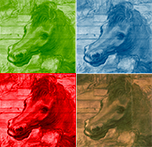Neutron can investigate the structures of the materials with high- and low-resolution techniques. Neutron Diffraction (ND) is a high-resolution technique and investigates, in a non-destructive way, atomic positions and lattice spacings, and it is very useful for the determination of the crystalline phases and structures of the solid materials, such as minerals, metals or metallic oxides on atomic scale. Neutron are able to provide information on internal stresses in material as well as on texture of metallic phases, as well. Textures may reflect the thermomechanical history of the investigated metallic objects, such as, antique swords, sculptures other metallic artefacts. Small Angle Neutron Scattering (SANS) is a low-resolution technique and it explores, in a non-destructive way, nano-structural features of size between 1 and 500 nm. Nano-structural features are inhomogeneities imbedded in the investigated materials. It gives information about the orientation, size, size-distribution, agglomeration, quantity of the nano-domains inside the sample, which can be correlated to several macroscopic characteristics of the material, such as firing temperature of clays and bricks, oriented strain or stress that affected the raw material, the fabrication procedure, deterioration degree of textiles, etc. SANS can also be considered as a complementary technique to Electron Microscopy (EM).
Fields of application
-
Cultural heritage
sculpture, archaeological object
-
Natural heritage
fossil, mineral, shell, skeleton
Materials
-
inorganic
glass, stone, metal and metallurgical By-Products, ceramic (clay, mud brick, terracotta, earthenware, stoneware, porcelain)
-
organic
wood, paper, textiles
TOOLS

The FSANS instrument is a recently built instrument at the Budapest Neutron Centre site, used for non-destructive study of the nano-structural features of various materials, among them archaeological objects. The studied size range is between 10 nm and 500 nm. Because of its technical characteristics, it is complementary to the Yellow Submarine SANS Instrument.
Provider
Budapest Neutron CenterContact person
Adél Len
The Small Angle Neutron Scattering (YS-SANS) instrument is composed of : 1. The SANS diffractometer Yellow Submarine covers a Q-range of 0.003 to 0.7 Å-1 allowing to probe structures at length scales from 5 Å to 1500 Å. It has a wide range of applications from studies of defects and precipitates in materials, alloy segregation,...
Provider
Budapest Neutron CenterContact person
Adél Len
The instrument is installed at a radial thermal neutron beam. The monochromator system consists of a fast double and two single choppers and a straight neutron guide with 2.5X10 cm2 cross section at the exit. The double chopper is designed for a maximum speed of 12000 rpm. While in high resolution mode the very short...
Provider
Budapest Neutron CenterContact person
György Káli
KWS-2 is a very versatile SANS instrument able to investigate inhomogeneities in the materials up to a dimension of about 1000 nm. KWS-1 is equipped with a large variety of sample environment that are used in-situ during the measurements to reproduce the proper conditions neede for the experiment. Detailed technical and experimental information is available...
Provider
Heinz Maier Leibniz ZentrumContact person
Aurel Radulescu
KWS-3 is a very Small-Angle Neutron Scattering instrument with a focusing mirror that increase the size of investigating inhomogeneities in the material. It is recommended to investigate large inhomogeneities in the material. Detailed technical and experimental information is available at the web page of the instrument https://mlz-garching.de/kws-3
Provider
Heinz Maier Leibniz ZentrumContact person
Vitaly Pipich
SPODI is designed to investigate on the structure of crystalline powders. It is recommended for those investigations that requires crystalline phase determination and transformation in ancient materials. Detailed technical and experimental information is available at the web page of the instrument https://mlz-garching.de/spodi
Provider
Heinz Maier Leibniz ZentrumContact person
Anatoliy Senyshyn
STRESS-SPEC reveals the textures and the residual stresses of the materials. It is recommended to investigate on the ancient manufacts to determine their production processes and therefore providing useful information for dating them. Detailed technical and experimental information is available at the web page of the instrument https://mlz-garching.de/stress-spec
Provider
Heinz Maier Leibniz ZentrumContact person
Michael Hofmann
KWS-1 is a very versatile SANS instrument able to investigate inhomogeneities in the materials up to a dimension of about 1000 nm. KWS-1 is equipped with a large variety of sample environment that are used in-situ during the measurements to reproduce the proper conditions neede for the experiment. Detailed technical and experimental information is available...
